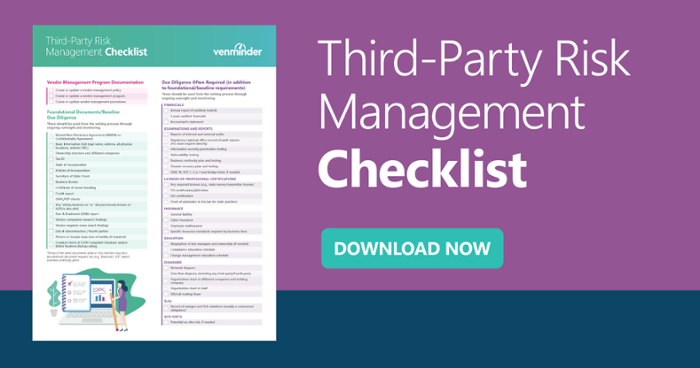We know all too well the stress of an upcoming vendor management exam. We’ve been there — many times, and if we’ve learned anything about making the process a little less anxiety-inducing it’s keeping one age-old adage top of mind: by failing to prepare, you are preparing to fail. The real secret is all in doing your homework… well ahead of time.
But along with that sentiment, there are typically seven areas of focus you’ll want to get in order well before exam time.
How to Proactively Prepare for a Vendor Management Exam
1. Documentation of Your Vendor Management Policies and Procedures
Well before the exam, you’ll want to make sure you have all your board-approved outlines of all the facets of your third-party risk management program. This should be up-to-date and reflective of all recent regulatory compliance guidance (be sure to cite it specifically) which also means it’s a good idea to loop in both your compliance team and your internal audit team well ahead of the exam so they can help fill in any gaps.
2. Prepare Your Third-Party Vendor List
Your regulator will also want to make sure you have a list of all your active vendors, organized by both business impact risk — either critical or non-critical — as well as regulatory risk level: high, moderate or low. This list should also include well-written risk assessments for each of these vendors as well as any documentation covering ongoing management and/or monitoring. Separate categories of vendors that require more frequent active management (higher-risk third parties) from vendors that require inventory but don’t require as much ongoing monitoring such as maintenance or janitorial services.
Tip: If there are specific vendors who may be out of your monitoring scope, like a food delivery service, it’s typically a good idea to do some additional internal checks and explain why they’ve fallen in this area.
3. Proof of (Risk-Based) Due Diligence
Regulators like to see evidence of due diligence on all your active vendors, and especially around your most critical third-party vendors. More due diligence will likely be done on critical and high-risk third parties, however it’s important to periodically perform due diligence on your low and moderate-risk vendors as well. Your high-risk and critical vendors should be listed along with their corresponding financials, SSAE 18 and SOC reports, as well as any security assessment analyses. Make sure to also include a fully fleshed out business continuity plan that outlines the roles of each of these critical vendors within your organization.
Other items you may want to include here are insurance certificates, licensing and notes on actionable exit strategies. Here, as always, accuracy and timeliness are of the utmost importance. Be detailed and make sure your records are as current as possible. When in doubt, leverage the knowledge of subject matter experts.
4. Completed Third-Party Risk Assessments
While we already mentioned that risk assessments should be included within your comprehensive documentation, it doesn’t hurt to underscore the importance of outlining consideration around any and all potential risks associated with your vendors.
Tip: Ideally, the descriptions of these risks should correspond with your organization’s statement of risk (risk appetite statement). Keep an eye out for consistency.
5. Record of Ongoing Vendor Monitoring
The type of ongoing monitoring you’ve documented very much depends on the type of vendor as well as their category and level of risk. Your ongoing monitoring strategy could range from social media monitoring and call center listening to transaction testing. Regardless, this is a solid best practice and a regulatory expectation. Analyze your vendors according to an annual calendar, not just during vendor vetting, to help eliminate concerns way ahead of examination time. If it's not directly in your area, make sure there's a specific individual accountable and that they understand their responsibilities.
6. Documented Contract Management Process
In this area, regulators are looking to make sure expiration dates and termination notices haven’t been overlooked and that certain provisions are included to help protect all parties involved. Remember, your vendor oversight is only as a strong as your contract, so make sure to keep track of any routine contractual standards your organization has in place including provisions around service level agreements (SLAs), security and confidentially, fourth parties and compliance documents. Typically, it’s good practice to have a point person or a centralized system to help keep this process unified.
7. Senior Management & Board Reporting
It’s typically a best practice that third-party risk management is independent of the lines of business. It’s also mandated by regulatory guidance that this separate group – the third-party risk management team – has a direct reporting relationship to senior management or the board of directors. If it is a separate area, comprehensive reporting helps so the involvement doesn’t get watered down in the day-to-day work of another business area. Regulators like to see detailed reporting (evidenced in minutes, if possible) of all of the above areas.
Exam prep is much like eating an elephant: one bite at time. There’s a lot there, but if you leverage internal expertise and make sure to keep things up-to-date and organized, you’ll find exam time a whole lot easier.
Do you have the necessary documents and procedures in place for vendor management? Download the checklist.



















